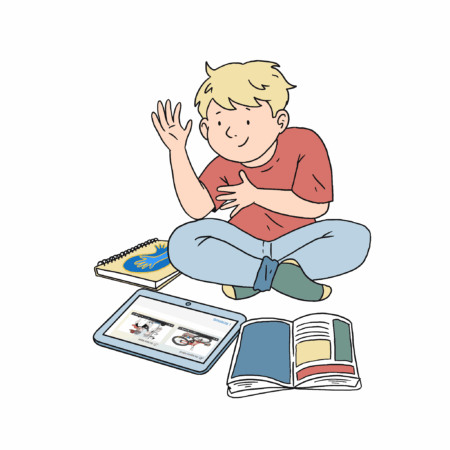“Sign languages for pupils: Thinking about grammar” is designed to foster language awareness. It provides content and ideas for teaching sign language grammar but does not offer specific exercises.
Ideas for teaching
Flexible use
“Sign languages for pupils: Thinking about grammar” is…
independent of textbooks:
You can combine this website with other teaching materials.
independent of curricula:
You can decide for yourself when you want to work on which topic or which chapter with your pupils.
multilingual:
The explanations are bilingual in the respective sign language and in a written language. This makes it suitable for use in linguistically diverse groups.
modular structured:
It is not necessary to work through all topics and chapters one after the other. Depending on your curriculum and your pupils, you can spread the work over several lesson series or year groups.
You can use the materials to create your own exercises.
The teacher is central
“Sign languages for pupils: Thinking about grammar” is a resource to support teachers and learners. The website does not replace you as a teacher. You always have a central role in explaining the structures of sign languages:
Be a role model
Take an active role so that pupils can learn from you how to analyse communicative functions and linguistic means, and how to use technical terms. As a language model, demonstrate variations in your sign language. This includes, for example, dialectal differences, differences in the execution of a sign, and different registers.
Encourage reflection and exchange
Promote interaction between pupils so they can support each other and share their linguistic knowledge and perspectives. This enables a joint and thorough analysis of sign language, which in turn helps to develop language awareness. You can also encourage self-correction and peer correction.
Observe language awareness
Observe how your pupils develop. You can recognise when pupils become aware of language when they, for example,
- ask questions about sign vocabulary and grammar;
- crack language-based jokes;
- compare different languages (written, spoken and signed);
- correct themselves and others;
- consciously adapt their language to their conversation partners or to the situation;
- use different signing styles, e.g. in role play.
Examples of the use of the website
Lesson preparation
- Use the topics to deepen your own understanding of the structures of a sign language. In addition to the topics, the website also offers explanations of additional technical terms.
- Acquire the technical terms in both your sign language and your written language and use them for describing the sign language you are teaching.
- Prepare exercises and teaching materials using the resources from “Sign languages for pupils: Thinking about grammar” e.g. with stories and dialogues from “Have a look”, drawings and graphics. You can download all the material free of charge from this website.
- Study the learning objectives for each topic. Determine which topics or which chapters of the topics are suitable for your group of pupils.

Using the website in the classroom
Introduction to the communicative function
- Together with your pupils, watch a signed text from “Have a look”. Pupils can also look at the text alone or in groups. Ask questions about the signed text to ensure they have understood it.
- You do not have to use all of the signed texts. Choose one or two texts that match the chapter of the teaching topic that you want to cover.
- Explain the communicative function (e.g. “How to express time”).
- Have the pupils look for where the communicative function occurs. For example, ask them: “Where do the signers in this signed text express time?”
Development of the linguistic means
- Choose the linguistic means you would like to introduce. You do not have to work on all linguistic resources one after the other, but you can also spread them over a series of lesson or over groups.
Work with the pupils on a linguistic means and the associated technical terms. You can look at the explanations with the pupils or let the pupils study them individually or in pairs. - First, clarify the connection between linguistic means and communication functions using the selected signed text examples from “Have a look”. Then, look at the other examples on the website together with the pupils. Ask pupils to contribute their own examples and explain how these relate to the communication function.
- Use another signed text from “Have a look” to consolidate what they have learned. Alternatively, pupils could look for the linguistic means in the signed texts they have just worked on.
- Pupils can also create new texts themselves to consciously apply the communicative function they have learned.
- Consolidate new technical terms by assigning the written language word to the technical sign or by asking pupils to explain the technical terms themselves.
Compare dialects and sign languages
- The grammar explanations are signed in regional variants. Discuss regional and social differences with the pupils to foster language awareness. They do not have to stick to the dialect used in the video but can use their own variant or dialect instead. The pupils then understand that there are variations in their respective sign language, and they learn to become flexible.
- On the website, you can choose from five different sign languages. Encourage pupils to compare how a communicative function is expressed in different sign languages.

Homework/self-study
- Allow pupils to study at a topic or chapter at home. They can use it to prepare for or follow up on lessons. For example, homework could involve pupils working on a chapter independently and then presenting it to the class. Alternatively, pupils can be assigned the task of analysing a signed text and with the help of the website.

